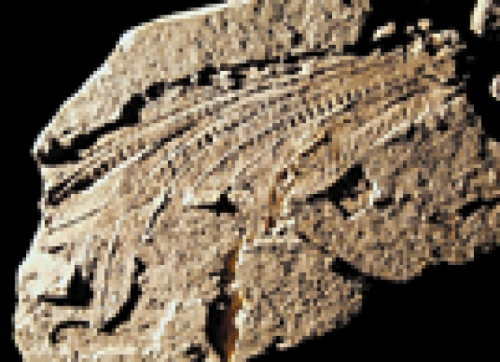Imagine a small reptile, roughly the size of a mouse, stalking insects through a late-Triassic forest in what is now central Asia. Hardly seems the path to international fame. But this creature, an archosaur named Longisquama insignis, has ignited scientific controversy some 220 million years after its death. The interest stems from the six vanelike appendages attached to either side of Longisquama’s back. Alan Feduccia, chair of biology and an ornithologist, believes the appendages were nonavian feathers and that early archosaurs were the ancestors of modern birds.
Longisquama is controversial because it’s not a dinosaur, and most paleontologists believe that birds evolved from dinosaurs. “These are the earliest structures in the fossil record that can be called feathers,” Feduccia says. “They predate the so-called ‘fuzzy dinosaurs’ from China by at least 100 million years.”
Found in 1969, Longisquama’s fossilized remains escaped the limelight for 31 years—perhaps because its slender appendages were interpreted initially as scales (Longisquama means “long scale”). Feduccia was allowed limited access to part of the fossil on a trip to Moscow in 1982, but for the most part, the fossil languished in a drawer at the Russian Academy of Sciences. In 1999, it was included in a traveling exhibit that stopped at a Kansas City mall, where the fossil caught the eye of Oregon State University zoologist John Ruben and his graduate student Terry Jones.
The Russians agreed to submit the fossil to scientific scrutiny, and Feduccia was part of the team that studied it. They found arresting parallels between the appendages and feathers—most notably, a hollow shaft with a sheath characteristic of modern feathers.
“What this really shows,” Feduccia says, “is that the genetic and developmental potential to produce feathers was present in these early archosaurs.” The team also deduced that the feathers weren’t used for thermoregulation but likely allowed the creature to glide between trees.
The suggestion that Longisquama was feathered has far-reaching implications because many scientists believe that features as specialized as feathers had only one path of evolution. So, if feathers evolved in Longisquama, which occupies one branch of the immense archosaur family (a subclass of reptiles), they are unlikely also to have evolved in another archosaur—say, a theropod dinosaur. Paleontologists who believe that birds evolved from theropod dinosaurs cite skeletal similarities and cladograms—computer-generated family trees based on shared anatomical characteristics—as evidence. But Feduccia has never been convinced of this view. “Birds can’t have come from theropod dinosaurs because the fossil record shows the time line is all wrong,” he says. He notes that theropod dinosaurs appeared some 30 to 70 million years after the earliest known bird.
“I believe that the truth will come out eventually,” Feduccia says. “It certainly is a dramatic discovery.”
Janet Wagner was formerly a staff writer for Endeavors.
The team’s findings were reported in the June 23 issue of Science. Feduccia is one of nine authors of the article.


